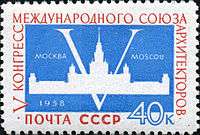International Union of Architects
The International Union of Architects (French: Union internationale des Architectes, UIA) is the only international non-governmental organization that represents the world's architects, now estimated to number some 3.2 million in all.[1] The UIA was founded in Lausanne, Switzerland, in 1948. The General Secretariat is located in Paris. It is recognized as the only global architecture organisation by most United Nations agencies, including UNESCO, UNCHS, ESOSOC, UNIDO, and the World Health Organization, as well as the WTO. The current (2017-2020) president is Thomas Vonier from the United States of America.
| Abbreviation | UIA |
|---|---|
| Formation | 1948 |
| Type | INGO |
| Location | |
Region served | Worldwide |
Official language | English, French |
President | |
| Website | www |
Congresses
The UIA convenes the World Congress of Architects every three years, each organised by a UIA member section that has competed for the honour. The UIA General Assembly meets during the World Congress of Architects, to conduct the business of the UIA and to elect UIA officers for a three-year term.[1]
Former congresses were:
| Nr. | Year | Location | Theme |
|---|---|---|---|
| 1st | 1948 | Architecture Faced with its New Tasks | |
| 2nd | 1951 | How Architecture is Dealing with its New Tasks | |
| 3rd | 1953 | Architecture at the Crossroads | |
| 4th | 1955 | Architecture and the Evolutions of Building | |
| 5th | 1958 | Construction and Reconstruction | |
| 6th | 1961 | New Techniques and New Materials | |
| 7th | 1963 | Architecture in Underdeveloped Countries | |
| 8th | 1965 | The Training of Architects | |
| 9th | 1967 | Architecture and the Human Milieu | |
| 10th | 1969 | Architecture as a Social Factor | |
| 11th | 1972 | Architecture and Leisure | |
| 12th | 1975 | Creativity and Technology | |
| 13th | 1978 | Architecture and National Development | |
| 14th | 1981 | Architecture, Man, Environment | |
| 15th | 1985 | Present and Future Missions of the Architect | |
| 16th | 1987 | Shelter and Cities - Building Tomorrow's World | |
| 17th | 1990 | Cultures and Technologies | |
| 18th | 1993 | Architecture at the Crossroads - Designing for a Sustainable Future | |
| 19th | 1996 | Present and Futures. Architecture in Cities | |
| 20th | 1999 | Architecture of the 21st Century | |
| 21st | 2002 | Resource Architecture | |
| 22nd | 2005 | Grand Bazaar of Architectures | |
| 23rd | 2008 | Transmitting Architecture | |
| 24th | 2011 | DESIGN 2050 Beyond disasters, through Solidarity, towards Sustainability | |
| 25th | 2014 | Architecture otherwhere | |
| 26th | 2017 | Soul of City | |
| 27th | 2020 | All Worlds. One World. Architecture in the 21st Century.[2] | |
| 28th | 2023 | Copenhagen | Design for a Sustainable Future |
Prizes
Since 1961 the UIA awards four prizes triennially:[3]
- Auguste Perret Prize, for technology applied to architecture
- Sir Patrick Abercrombie Prize, for town-planning or territorial development
- Jean Tschumi Prize, for architectural criticism or architectural education
- Sir Robert Matthew Prize, for improvement in the quality of human settlements.
UIA Gold Medal
Since 1984 the organisation also awards the UIA Gold Medal to honour an architect (or group of architects) having distinguished themselves through their work and professional practice by the quality of services rendered to man and society.[3] Past recipients of the award were:
| Year | Architect | Country |
|---|---|---|
| 1984 | Hassan Fathy | Egypt |
| 1987 | Reima Pietila | Finland |
| 1990 | Charles Correa | India |
| 1993 | Fumihiko Maki | Japan |
| 1996 | Rafael Moneo | Spain |
| 1999 | Ricardo Legorreta Vilchis | Mexico |
| 2002 | Renzo Piano | Italy |
| 2005 | Tadao Ando | Japan |
| 2008 | Teodoro Gonzalez de Leon | Mexico |
| 2011 | Álvaro Siza Vieira | Portugal |
| 2014 | Ieoh Ming Pei | USA |
| 2017 | Toyo Ito | Japan |
International design competitions
The UIA manages international architecture competitions for some of the most important spaces of our age. The UIA managed international design competitions that resulted in these important buildings:
- Georges Pompidou Centre, Paris
- Indira Gandhi Centre, New Delhi
- Bibliothèque Nationale de France, Paris
- National Museum of Seoul
- Prado National Museum, Madrid (rehabilitation and extension)
- Opera House, Sydney
Work Programmes
Architecture & Society
- Heritage and Cultural Identity
- Architecture and Children
- Architecture for All
Habitat
- Intermediate Cities:Urbanism and Architects Learning Platform (UIA-CIMES)
- Community Architecture: Architecture and Human Rights (UIA-CA+HR)[4]
- Social Habitat
Public Facilities
- Public Spaces
- Educational and Cultural Spaces
- Sports and Leisure
- Public Health
References
- UIA homepage Archived 2009-10-09 at the Wayback Machine
- "The IAB presents the official logo of the 2020 UIA congress in Rio | INTERNATIONAL UNION OF ARCHITECTS". web.archive.org. 2017-11-13. Retrieved 2019-10-22.
- UIA homepage: prizes Archived 2009-10-09 at the Wayback Machine
- "UIA | Community Architecture and Human Rights". Community Arch. Retrieved 2019-10-22.

